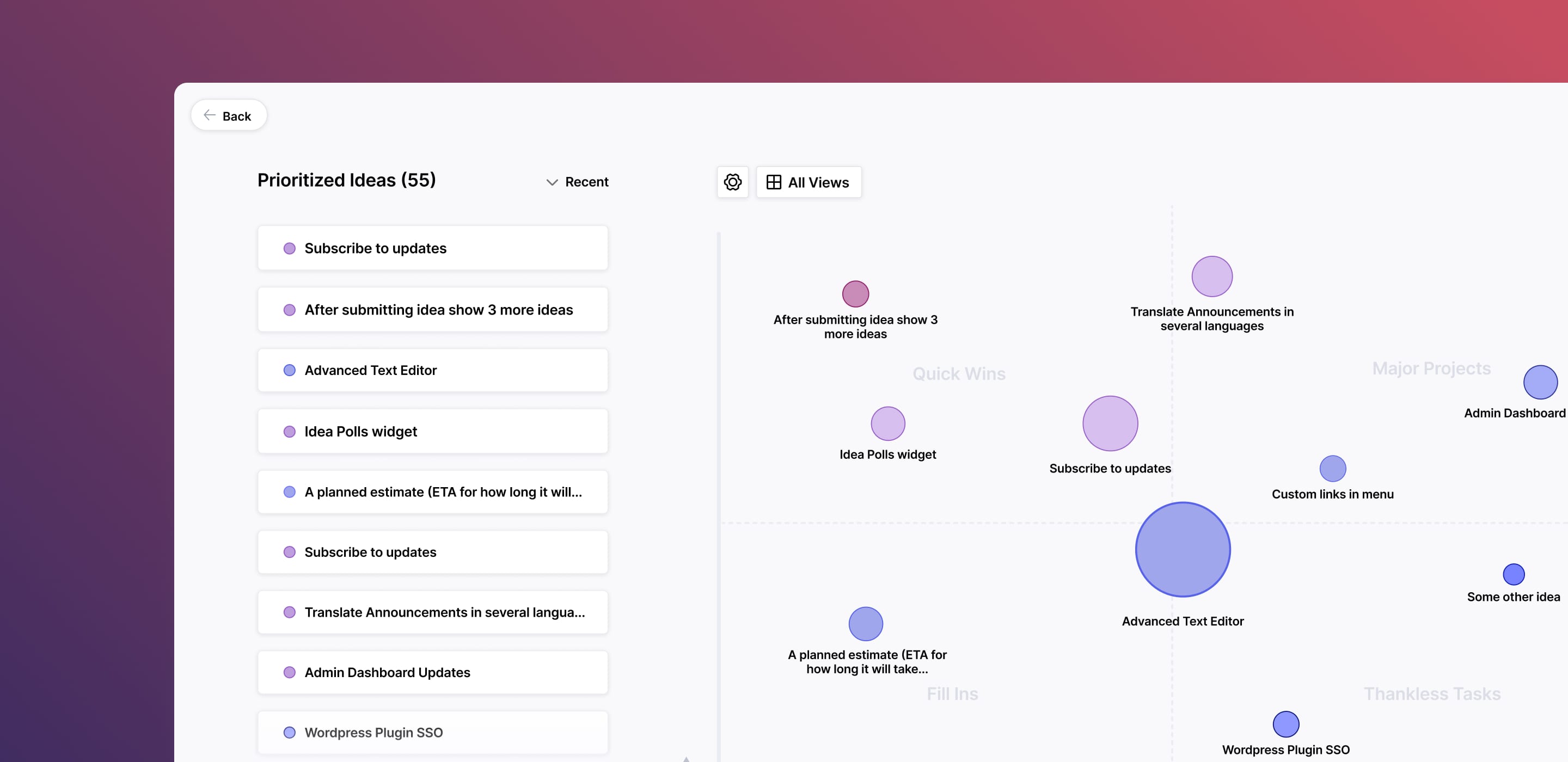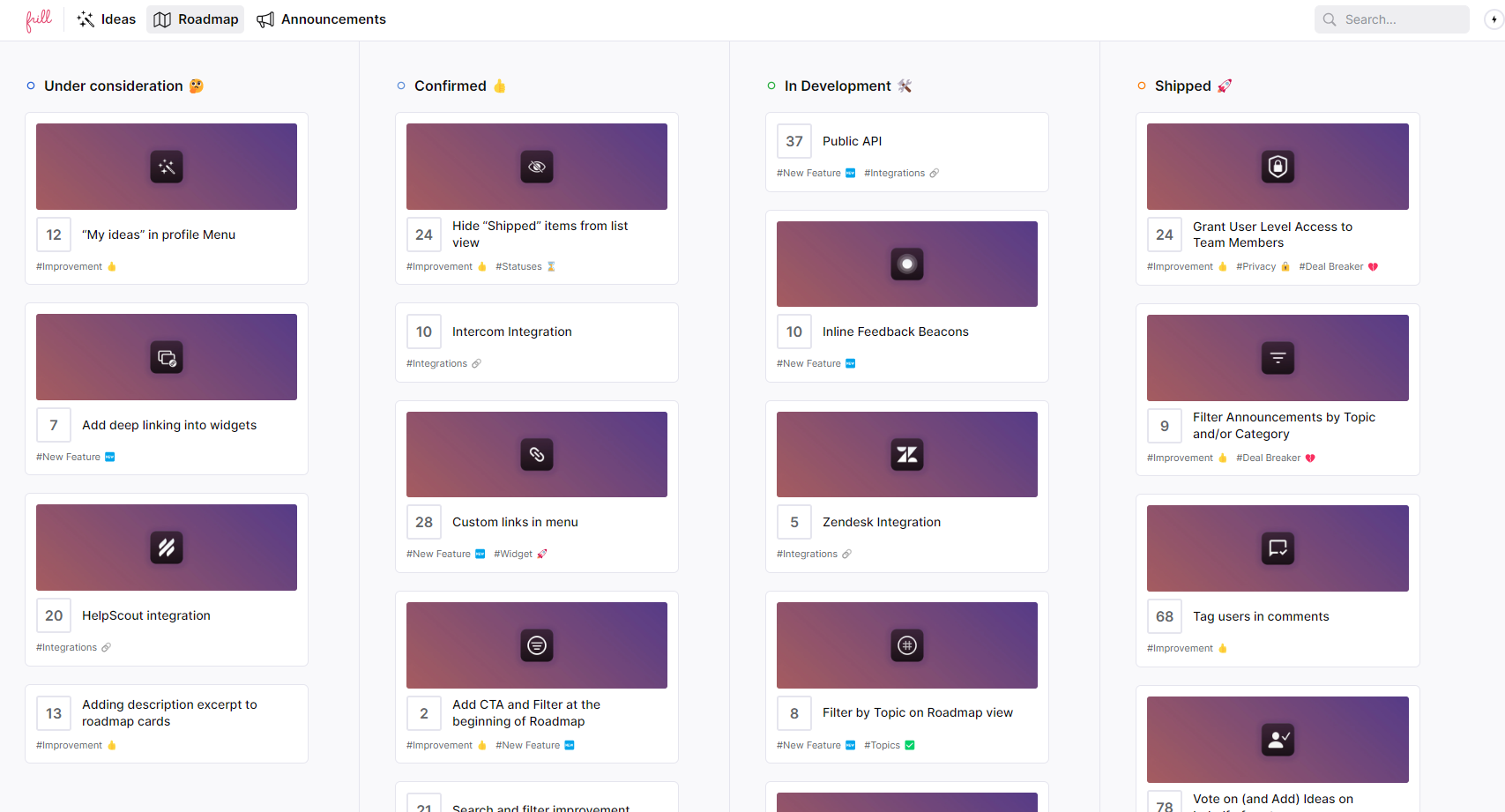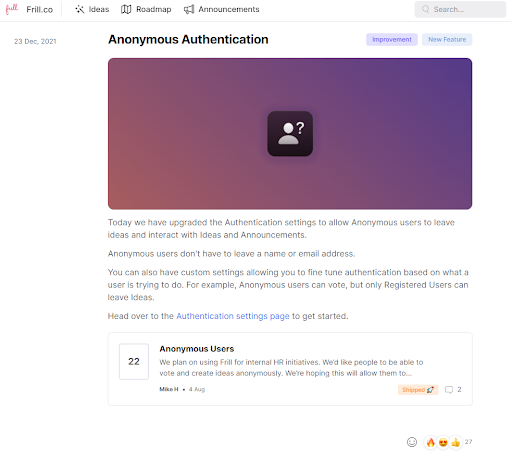6 Ways to Handle Feature Requests [+The Ideal Process]

By Dayana Mayfield
Last updated on Wed Jan 07 2026
Feature requests are an integral part of the project management process for SaaS companies. You can discover new ways to improve your product and enhance the trajectory you’ve established on your company's roadmap. Proper handling of feature requests also strengthens the bond between you and your users. They feel listened to and know that you support them and their needs.
Understanding the importance of feature requests is one thing–handling them is another.
If not properly handled, feature requests can become a time-consuming burden that affects your productivity and scatters the focus of your team.
In this guide, we explore some common ways to handle the feature request process, discuss the ideal process for SaaS companies, and share some management tips.
The ideal feature request process for SaaS companies
Follow these seven steps to create the ideal feature requests process for your SaaS business.
1. Set up a feature request board
First, you need to setup your feature request board using your chosen software. If you haven't decided on a software yet, then here are some feature request tools to consider.
Make sure you choose one with a great UX. UX is everything, and the easier it is for your customers to use, the more they will use it. You will also want a feature request board that can integrate with your sign-on process—anonymity won’t allow you to engage with your customers.
Fill’s feature request board is super easy to use and has amazing UX.
Smart setup tips
Start strong by setting up your feature request board in a way that maximizes engagement and sets your product team up for success.
Integrate with SSO – Require user authentication to identify who submitted each request and follow up with them later.
Add priority tags – Use tags like “High Impact” or “UX Fix” to help your team filter and sort ideas quickly.
Pre-fill ideas – Seed your board with internal ideas or FAQs to model good submissions and encourage participation.
Translate the interface – Make your board accessible to international users by offering multiple language options.
2. Add a widget to your web app
Once your feature request board is setup, you’ll want to add an in-app widget. A widget provides a simple convenient way to spread awareness about your designated board for product improvement and for your users to engage with it.
Widget placement
Your widget is the most visible entry point to your feedback system, so it’s essential to position and configure it for maximum adoption.
Place widgets strategically – Embed your widget in high-traffic areas like the dashboard, support pages, or help center.
Use clear, inviting prompts – Replace generic labels with action-oriented language like “Got feedback?” or “Suggest a feature.”
Create multiple widgets – Tailor different widgets to different user journeys (e.g., onboarding, post-purchase, admin users).
Target specific user segments – Show or hide widgets based on user type, activity level, or lifecycle stage.
3. Promote your new feature request system
Promoting your new feature request system is critical. In addition to the in-app widget, you’ll want to add a button to your announcement page, post on social media, write a blog, and send out a one-time email announcement blast.
How to promote your feature request board
Getting the most out of your feature request board requires promoting it consistently across all relevant user touchpoints.
Use announcement pop-ups – Highlight your feedback board in product updates or changelog notifications to drive discovery.
Add CTAs to onboarding – Include a “Suggest an idea” link in welcome emails or product tours to train new users early.
Share top ideas on social – Promote trending or shipped ideas on social media to increase participation.
Re-promote periodically – Reintroduce the board every quarter or after major launches to reach newer users.
4. Prioritize incoming feature requests
Make sure you are prepared to prioritize new feature requests. You will want to consider features that align with your roadmap or current sprints. Another option is the RICE system–which stands for Reach, Impact, Confidence, and Effort. RICE scores new feature requests based on the four criteria and provides an objective method for deciding which features to build.
With Frill you can use the RICE system or build your own prioritization framework.
A prioritization matrix will also help you visualize trends and common requests by pulling data from feature requests and combining them by similar terms and concepts. This makes it easy to decide the next features to implement.

Ways to prioritize
Once requests start flowing in, you’ll need a reliable system to assess what to build and when, based on data and strategy.
Use RICE or a custom system – Apply a scoring model like RICE or build your own to rank ideas objectively.
Sync with dev tools – Connect Frill to tools like Jira or Trello to seamlessly push validated ideas into your backlog.
Surface duplicates – Let Frill’s automatic duplicate detection reduce noise and keep the board clean.
Track momentum over time – Monitor which ideas are gaining traction to catch emerging trends before they peak.
5. Add approved feature requests to your public roadmap
Once a feature request has been approved for development, make sure you add it to your public roadmap. This way your users can see at any time what features are in the product improvement pipeline. Using Frill for your roadmap allows you to drag and drop feature requests in the appropriate columns. Now, your feature request tracking and roadmapping are managed under one roof.

How to display your roadmap
Your public roadmap is a signal of transparency and momentum. Make sure it’s clear, engaging, and aligned with customer expectations.
Use micro roadmaps – Create topic-specific roadmaps for different products, regions, or user segments.
Add feature images – Include images or mockups to build anticipation and help users visualize what’s coming.
Pin strategic features – Highlight the most impactful or differentiating features at the top of your roadmap.
Link to original requests – Maintain full context by linking roadmap cards to the original user-submitted ideas.
6. Develop top-priority features
Don’t attempt to develop all feature requests. Doing so would cause feature overwhelm and will ultimately dissuade people from using your SaaS product. Stay on target and only develop the top-priority features.
If a feature request does not make the cut, that is ok but be sure to reach out to the requester and let them know you took the time to consider it and why you have decided not to develop it.
Development alignment tips
Not every feature should be built. Focus on execution and communication to maintain trust—even when saying no.
Notify followers automatically – Let Frill’s notifications system update requesters when a feature is being built or released.
Ask follow-up questions – Engage with idea voters during development to clarify use cases and refine solutions.
Convert to private bugs – For internal issues, move submitted items to private bug status to avoid public confusion.
Vote on behalf of users – Let customer-facing teams log feedback and votes from calls, emails, or chats.
7. Announce updates on your changelog
Project managers should write release notes to announce updates to the changelog to share details on what's been built and why. You might even consider producing a short video to go along with the announcement.
Writing release notes with Frill allows you to directly tie the announcement to the exact feature request that prompted it.
For example, we’ve connected the feature request titled “Anonymous Users” to our Anonymous Authentication update.
Changelog best practices
Your changelog is more than a release log—it’s a storytelling tool. Use it to close the loop, educate users, and celebrate progress.
Include a demo video – Even a short video can make complex features easier to understand and more likely to be adopted.
Enable emoji reactions – Let users respond to changelog posts to quickly gauge interest and sentiment.
Link back to requests – Tie each update to the original feature request to demonstrate responsiveness.
Segment announcements – Use Frill’s targeting features to show relevant changelog items to different user groups.
6 common ways to handle the feature request process
There are many ways to communicate with your clients. By the same token, there are many ways to receive feature requests and lots of tools for managing them.
Here are some common ways you can handle your feature request process.
1. Idea board with in-app widget
An idea board is a place where ideas can be collected and visualized. For feature requests, an easy-to-use idea board combined with an in-app widget is a great option as it allows your users an easy method to post their requests and provide customer feedback.

Pros: Idea boards provide clarity, increase customer engagement, and demonstrate a customer focused approach to improvement. Adding an in-app widget also controls the collection of feedback and links the requests to your customers for subsequent communications.
Cons: Your feature requests are more transparent to your clients. If this is an issue for your company, then you will want to consider other methods for obtaining product feature requests.
Tool options: Frill, Upvoty, and Rapidr
2. Website forms
Website forms are a way to collect qualitative and quantitative feedback on your website. They are a great tool when you are looking for solicited feedback.
Pros: Website forms are good for managing data. They’re convenient and efficient, can be changed anytime with immediate effect, and allow for real-time data collection.
Cons: They are time-consuming and expensive to maintain, need to be secured if you want to protect the submitted data, and are vulnerable to “form bots” and survey fraud which will distort your data.
Tool options: Submittable, Jotform, SurveySensum and PandaDoc
3. Surveys
Surveys provide a nice way to collect directed feedback. This works well when you are trying to hone in on specific topics or you want the feedback to be more focused on prioritizing vetted options to develop.
Pros: Surveys are easy to develop, quickly obtain results, and allow for easy statistical analyses.
Cons: You cannot always trust the honesty of answers in surveys and you may receive unclear answers if the question or response options are not clear themselves.
Tool options: SurvayMonkey, Alchemer, and Qualtrics
4. User research interviews
Interviews are a tried-and-true method of discovering user insights. They can help you gain an in-depth understanding of your users' perceptions, values, and understandings. When paired with other product improvement request methods, interviews can assist in prioritization.
Pros: Your product is designed to solve a set of specific problems and your roadmap exists to help you navigate your growth. User research interviews allow you to gain a broader insight into the UX of your product for targeted audiences such as your ICP.
Cons: Interviews are very time-consuming. You have to find participants, schedule the calls, and sift through the notes. They are not good at getting to the “what” which is better addressed by other methods like idea boards. The removed nature of the interview makes it subjective and based on the memory of the interviewee whereas an in-app widget allows the feature request to be made in the moment.
Tool options: User Interviews, Hotjar, and Userfeel
5. Focus groups
Focus groups allow you to gain important insights into customer preferences, behaviors, and opinions. They also provide a great means to test new products, identify needs and wants, evaluate marketing campaigns. There are five main types of focus groups and three categories of interviews–structured, unstructured, and semi-structured.
Pros: Participants are chosen based on targeted criteria. The primary benefit is that it allows you to collect insightful data while connecting with your users. They also produce insightful data, allow for body language observations, and are typically low cost.
Cons: Participants may be shy or unwilling to give information. A lot of preparation is required to select the type of focus group, the right participants, a good moderator, and the questions/discussions to be conducted. There are also challenges in engaging with large groups and keeping the discussion on track.
Tool options: Zoom, Google hangouts, and AdobeConnect
6. Forums and communities
Forums and communities allow your users to discuss issues, post questions, offer solutions, and make comments. They’re a great way to create engagement with your users in an unscripted or semi-scripted manner–you can post prompts and ask open ended questions to gain feature requests.
Pros: The open-ended nature of the discussions will undoubtedly reveal unique insights and allow you to obtain feature requests more informally. Paired with the right sentiment analysis tool, you can identify pain points that would otherwise be missed. Forums also encourage user engagement, which is always a good thing.
Cons: Keeping the conversations and discussions on topic is difficult. You will have to comb through a lot of content to find the relevant feature requests, and/or dedicate resources to moderate the content and keep the discussion on track.
Tool options: Zendesk, Discourse, and XenForo

Best practices for managing the feature request process
To make your ideal feature request process even better, consider these additional tips.
1. Allow upvoting
Upvoting is essential for managing feature requests. It is a simple method to increase the quantitative data of a request by allowing users to agree with feature requests submitted by other users. In turn, you get a very clear picture of what potential features your clients care about in a consolidated manner. Make sure you offer feature voting as part of your feature request process.
Frill offers built-in upvoting so customers can support existing ideas instead of submitting duplicates, helping teams quickly identify high-demand features.
2. Make it easy for users to comment on each other’s requests
Comments provide more context to a feature request and aid in the prioritization of the ideas. The easier it is for your users to comment on each other’s requests, the more qualitative data you will gain. This generates a more complete picture of what the request is trying to solve.
Frill allows users to comment directly on feature requests, making it easy to gather additional context and real-world use cases.
3. Implement SSO
Single sign-on (SSO) allows users to sign into various platforms with one set of credentials. Implementing SSO simplifies the use of a feature request app and increases customer participation in all aspects of the feature request process. You will also know which customers are submitting which requests and ensure that feature requests are coming from real users.
Frill supports SSO, allowing customers to submit ideas and engage with feedback using the same login they use for your SaaS product.
4. Keep users informed with status updates
A feature request process should not end when an idea is submitted. Users are more likely to continue sharing feedback when they can see progress and understand what is happening with their requests. Clear status updates help manage expectations and build trust.
Frill automatically notifies users when the status of a feature request changes, keeping them informed without requiring manual follow-ups.
5. Organize requests with tags and categories
As feature requests scale, organization becomes critical. Grouping similar ideas together helps product teams identify trends, reduce noise, and prioritize more effectively. Without structure, valuable insights can get lost.
Frill lets you tag and categorize feature requests, making it easy to organize feedback by themes, products, or strategic initiatives.
Frequently asked questions about managing feature requests
What’s the best way to collect feature requests without overwhelming the product team?
Use a structured system like an idea board with built-in upvoting and status tracking. This helps centralize requests, reduces duplicates, and allows users to self-prioritize by voting. Frill makes this easy with an in-app widget and a feedback board that organizes and filters ideas automatically.
Should every feature request be acknowledged or responded to?
Yes, ideally, every request should receive some form of acknowledgment. Even if a request isn’t accepted, users appreciate knowing it was reviewed. Frill’s automatic status updates and notifications make it easy to close the loop with minimal manual effort.
How do I prevent my roadmap from being hijacked by feature requests?
Use prioritization frameworks like RICE or a custom scoring system to weigh each idea against your roadmap goals. Not every request should make it into development. Frill allows you to score and categorize ideas so your roadmap remains strategy-first.
How can I deal with duplicate feature requests?
Duplicates can clutter your board and skew demand signals. Frill automatically detects and flags similar ideas at submission, which helps consolidate feedback and keep your board clean.
Is it better to collect feedback anonymously or through authenticated users?
Authenticated feedback is almost always better. It allows you to follow up, understand user context, and confirm that requests are coming from actual customers. Frill supports SSO so users can submit feedback with their existing login credentials.
What’s the difference between a feature request board and a survey?
A feature request board is continuous and open-ended, allowing users to submit and vote on ideas at any time. Surveys are best for targeted insights on specific topics or features. Frill supports both methods with its Idea Board and Survey tools.
How often should I review and prioritize new requests?
This depends on your release cadence, but for most SaaS teams, a bi-weekly or monthly review is ideal. Use this time to evaluate new requests, update statuses, and push approved ideas to your dev tools like Jira or Trello.
How do I communicate shipped features back to users?
The best way is through a public changelog. You can also send targeted updates to users who voted or commented. With Frill, you can link changelog entries to the original request and notify everyone who followed the idea.
Ready to handle feature requests for your SaaS company? Sign up and try one of Frill's low-cost plans and discover how easy the feature request process can be.